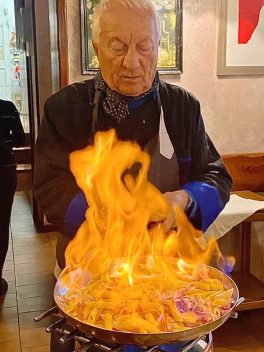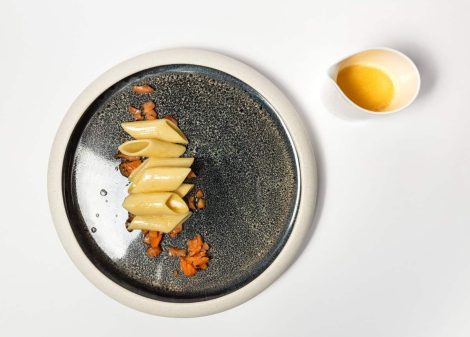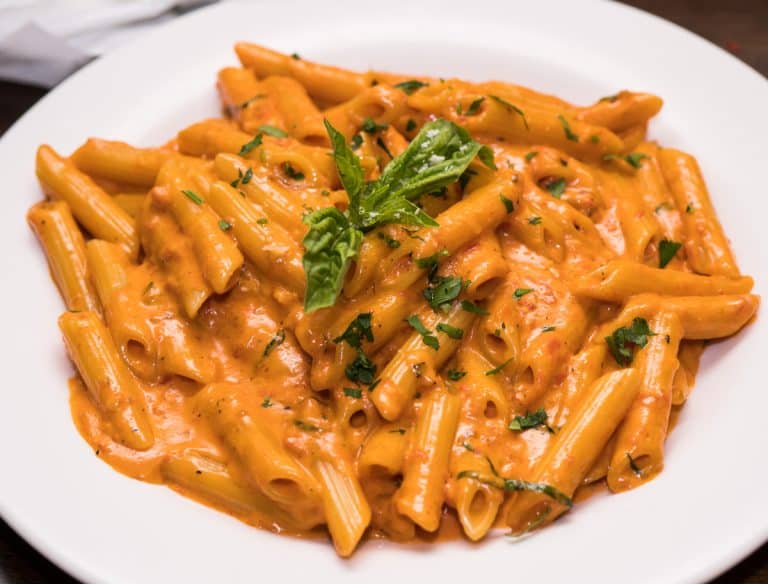One of the great fixations of our cuisine concerns the inventors of recipes. We are obsessed with knowing for sure the name and surname of the genius who gave birth to some famous dishes. Unfortunately, in most cases, these are very ancient creations that have changed shape many times over the centuries, and they don't have just one founding father, but really too many, and many anonymous ones.
Other times, the birth of a dish is due to fortuitous circumstances that are not recorded, leaving us only a handful of hypotheses, but without a real solution. Even for Penne alla Vodka, absolute uncertainty seemed to reign, but recently we found a testimony that sheds light on their true history. Many remember this dish when it was all the rage in the dazzling 1980s under the strobe lights of discos and now it seems almost forgotten. Abroad, however, it continues to be a flagship of Italian cuisine and has not suffered the ostracism known at home.
Penne alla Vodka: many fathers, few certainties
Research starts from the web, where we find some information and much confusion. There are several leads that should lead to the inventor of Penne alla Vodka. The first points to the Orsini restaurant in New York on 56th Street, opened by Armando Orsini in 1953 and remained in business until 1984. Ian Macallen, author of the book Red Sauce, reports that in the past their chef, Luigi Franzese, claimed paternity of the dish, claiming to have invented it in 1979. Despite further research, there are no other clues to support this hypothesis, which, as we will see, does not hold up under scrutiny. The other paths are even more hazy: a second New York track points to James Doty, a student at Columbia University, who would have created them in the 1980s, while Steve Seigelman in his Essentials of Italian, claims they are the work of an anonymous Roman chef who wanted to launch a vaguely defined brand of vodka.

Dante Casari
Between Rome and New York, one arrives in Bologna
Between Rome and New York, however, there emerges a suggestive hypothesis that points to Bologna. Pasquale Bruno Jr. advances it in the cookbook The Ultimate Pasta Cookbook, where it is written that Penne alla Vodka would have been invented at the Dante restaurant in Bologna. Opened in 1973 by Dante Casari, it immediately became one of the peaks of the city's gastronomy, distancing itself from the orthodoxy dictated by tagliatelle and tortellini. Dante thus becomes the temple of creative and international cuisine, so much so as to deserve a Michelin star in 1978. Four maîtres and a sommelier in the dining room, jet-set clientele, and, above all, many dishes never seen before under the two towers.
Dante's Penne
The restaurant has long been closed, and this track also seemed destined to remain unanswered if it were not for one particular detail: Dante Casari is in excellent health and is still active in his restaurant Papa Re alla Bolognina. Everyone knows him under the towers, and he was surprised when he learned that on Wikipedia pages, he was listed as one of the possible inventors of Penne alla Vodka. "I don't think I invented them," Dante Casari smiles today. "At the time, there were four maîtres in the restaurant who came from international experiences, they had worked in other cities and on cruise ships, it must have been one of those guys who brought them, but I can say for sure that we were already serving them in 1975." Dante brings out the photos of the time, when in his restaurant, orchids were changed every day, and service was done "à la lamp" in the dining room, jumping and flambeing dishes at the table. "That's why," he explains, "we made penne: they were more convenient to stir-fry, and the vodka ensured great flames without leaving any particular aftertaste." Dante Casari was certainly a pioneer, but he didn't invent Penne alla Vodka. In any case, he gives us the certainty of a date: by the mid-1970s, the recipe was already circulating in Italy. So the search continues...

The Tognazzi Hypothesis
Calling Ugo Tognazzi a cooking enthusiast would be an understatement. A genius inventor in the kitchen, as much as he was on the screen, he gave us many recipes and real performances, like when he cooked 30 kilos of spaghetti alla carbonara for 350 guests at the presentation of the film "Marcia Nuziale" at the Hilton in Manhattan. In his book "L'abbuffone," printed in 1974, among the many recipes, he describes "Penne all'infuriata" with garlic, chili, tomatoes, and vodka, a sort of upgrade of penne all'arrabbiata. Many have wanted to see in this recipe the prelude to the classic Penne alla Vodka, perhaps because even today in the United States, many cook them without bacon, but only with cream, tomato, and vodka with a base of sautéed onion or garlic. Although the idea is fascinating, putting vodka on arrabbiata pasta is not enough to invent Penne alla Vodka.
A very enjoyable documentary titled "Disco Sauce: The Unbelievable True Story of Penne Alla Vodka" was also dedicated to this hypothesis, made by Roberto Serrini in 2022 and winner of numerous awards. Thus, we discover that in New York, it is an extremely popular dish and is served in many Italian restaurants, including the famous Carbone, which offers it at $32 (!) per portion. The filmmaker interviewed several chefs, asking them for a personal interpretation of the recipe, embarking on a quest for the finest ingredients to cook the best Penne alla Vodka ever. A fascinating journey for us Italians, who consider them buried, while overseas they still drive people crazy, to the point that jars of ready-made sauce can be found in the supermarket, next to "bolognese," "marinara," and "Alfredo." Unfortunately, the documentary does not reveal new clues, and we must also discard the hypothesis of Ugo Tognazzi as the father of the famous dish. Let's move on. Actually, let's go back...
Rome, Osaka, Moscow
We are in 1970 at the World and International Exposition in Osaka, Japan (more simply known as "Expo '70"), and Italy is obviously present with its own pavilion. Four vehicles are on display, the result of Italian engineering: the two-seater fiberglass bobsled that won the 1968 Olympics, Giacomo Agostini's legendary MV Agusta 500 motorcycle, the FIAT 3 ½ HP from 1899 (the first to leave the Turin factory), and finally the futuristic Ferrari Modulo Pininfarina.
The pavilion's restaurant has 65 people between the dining room and the kitchen and continuously churns out spaghetti and tortellini, pizzas, and supplì. At the helm of it all is chef Mario Zorzetto, with the experience of three years earlier at the Montreal Expo. Perhaps this name will mean little or nothing to many, but at the time Mario Zorzetto was the animator of the Roman dolce vita: first with Café del Paris in via Veneto, then with Rosati where he served onion soup at 3 in the morning to characters like Vittorio Gassman, Fred Buscaglione, and Ennio Flaiano. During his career, he managed several restaurants such as Taverna Giulia and Elefante Bianco, but he also became the personal chef of Gianni Agnelli, Carlo De Benedetti, the Aga Khan, and Aristotle Onassis.
To find out what happened at the 1970 Osaka Expo, we turn to the book "Osterie della vita e dell'amore" published two years later by Livio Jannattoni, one of the greatest experts in Roman cuisine. In those pages, Mario Zorzetto recounts that relations with the other pavilions were anything but idyllic, except with the Russians. Late at night, after service, the chef cooked spaghetti for everyone, and the Russians, of course, brought vodka. It may have been the euphoric atmosphere of the evenings or nostalgia for grappa (Zorzetto was originally from San Donà del Piave), but in the end, the vodka ended up on the pasta, and thus Penne alla Vodka were born.
Rome by night
Back from the Japanese experience, Mario Zorzetto perfected the recipe and included it in the menu of his Taverna Giulia, giving it a place of honor alongside Spaghetti alla Gigi Riva, Fondue à la Bourguignonne, and Filetto alla Stroganoff. Two years later, the dish had already begun to spread in the capital, and we find it in at least one other restaurant, Valle (called "La biblioteca"), declined with cellentani instead of penne, but it doesn't matter much.
Rome was experiencing an extremely lively season from many points of view, even on the gastronomic front. In addition to the inevitable trattorias and restaurants of all kinds, you could also eat in discos and nightclubs, some of which offered haute cuisine dishes. In the sparkling nights of the Eternal City, it was not unusual to go to clubs to listen to music and dance, but also to eat dishes stir-fried under the lamp with flames that illuminated the dimly lit room. It is right there that Penne alla Vodka began their climb to success. In the same period, other recipes were born that copied their style, such as Penne al Cognac, a version without tomato (with cream and pancetta), or the variant called "alla moscovita," with smoked salmon, cream, and caviar. And vodka, obviously.

The gourmet interpretation of Penne alla Vodka by Corrado Parisi at Benso in Bologna (photo Aromi.group).
Penne alla Vodka and the Roman nightlife
If Penne alla Vodka had remained a Roman affair, perhaps nobody would remember them today, but in the 1970s, the capital was anything but an isolated city. Tourists, especially Americans, adored it. Not only for its ruins, culture, climate, but also for its gastronomy. In the city center, there were already huge "tourist traps" restaurants, such as Meo Patacca in Trastevere, which served up to 1,500 covers in one day. The owners were an American couple who decorated it with Roman memorabilia, ship models, and waiters in traditional costumes, making it resemble a Cinecittà set. And if the restaurant was a much-loved destination for Americans, it was much less so for Romans.
Penne conquering the West
Perhaps it was a passing tourist, or much more likely an Italian chef who emigrated to New York, who brought Penne alla Vodka across the Atlantic. After all, the exchange between the two shores of the ocean continued to give great dishes that enriched Italian-American cuisine. It is significant that the first mentions of Penne alla Vodka are found in American newspapers and that it is an American recipe book dedicated to Northern Italian cuisine that reports the first recipe. The first impressions, to be honest, were far from flattering, so much so that in 1981, the New York Times' "Dining out" column described the penne as "immersed in a sauce that tastes like an alcoholic Alfredo, an undefined mix of cream, cheese, and liquor." They also didn't have great critical success at home: Giovanni Nuvoletti, the historic president of the Italian Academy of Cuisine, in an article in La Stampa in 1983, labels them as a "disgusting dish."
Vodka and Russian charm
Perhaps some people still think that way today, but despite the negative reviews, the dish spreads like wildfire, infecting half the world. It is difficult to explain the success of Penne alla Vodka by looking for other elements if not the fact that they are really good. Perhaps their international soul played a role: pasta was typically Italian, cream represented the most popular part of French cuisine, smoked bacon winked at Anglo-Saxon palates, and, finally, vodka was a glimpse beyond the Iron Curtain to the other global superpower. This ingredient is the real novelty. Not from the taste point of view since it is the most tasteless liquor known, but for its ability to evoke new scenarios. We are talking about the years when Russia and the United States were vying for world supremacy, challenging each other in the arms race, in the conquest of space, and on the field of sports competitions. In the midst of the Cold War, this polyglot and globalized pasta attracts everyone's sympathies. Needless to say, Penne alla Vodka quickly became the symbol of Italian creativity in the kitchen: tasty, fun, easy, and fast, they represent the quintessential dish of disco nights and dinners with friends throughout the 1980s. As the new millennium approached, however, everything changed, and the penne were relegated to the corner, only to disappear later.
The disappearance, but only in Italy
The fate of disappearance, however, concerns only Italy: abroad, vodka sauce remains one of the most appreciated pasta sauces. The reasons that made this dish successful are the same ones that decreed its abandonment by Italians within twenty years. Too foreignophile to be recognized as a national dish: smoked bacon and vodka were certainly not two identity products of which anyone could invoke paternity. Not to mention cream, outlawed along with the dishes that had abused it: from tortellini, to tagliolini with salmon, to 3P pasta (cream, ham, and peas). Italians' incessant duty to justify every single dish with a reference to a culture as ancient as it is immobile, condemned Penne alla Vodka to exile. For us, they remain the symbol of the 1980s, a faded memory that has never changed face, like myths that disappear without aging. Penne alla Vodka is our Che Guevara.

An Amatriciana with cream and vodka
Exile, however, is not death. The United States continues to be a huge collector of global trends that spread and infect most Western countries (and not only). After all, this dish still preserves its culinary dignity, especially if cream is dosed with caution and excellent raw materials are chosen. We should be the first to claim the invention of Penne alla Vodka: finally something that our grandmothers didn't cook, but a symbol of Italian creativity appreciated by millions of people even today. Their Italian, or rather Roman, origins are due to a great interpreter of our cuisine, unjustly forgotten, and they could even be compared to the most sacred recipes of tradition. Perhaps you know the scheme that starts from cacio e pepe, then adds guanciale and obtains gricia, and from this with the egg makes a carbonara, or an amatriciana by adding tomato. Just take one more step, and the game is done. After all, what are Penne alla Vodka if not an Amatriciana corrected with the addition of a bit of cream?


 Meloni: "Tariffs? If necessary, there will be consequences. Heavy impact on agri-food sector"
Meloni: "Tariffs? If necessary, there will be consequences. Heavy impact on agri-food sector" The Government honours the greats of Italian cuisine, from Bottura to Pepe. Massari: "Thank you, Meloni, the only one who listened to us"
The Government honours the greats of Italian cuisine, from Bottura to Pepe. Massari: "Thank you, Meloni, the only one who listened to us" "We must promote a cuisine that is not just for the few." Interview with Massimo Bottura
"We must promote a cuisine that is not just for the few." Interview with Massimo Bottura Wine was a drink of the people as early as the Early Bronze Age. A study disproves the ancient elitism of Bacchus’ nectar
Wine was a drink of the people as early as the Early Bronze Age. A study disproves the ancient elitism of Bacchus’ nectar "From 2nd April, US tariffs between 10% and 25% on wine as well." The announcement from the Wine Trade Alliance
"From 2nd April, US tariffs between 10% and 25% on wine as well." The announcement from the Wine Trade Alliance






